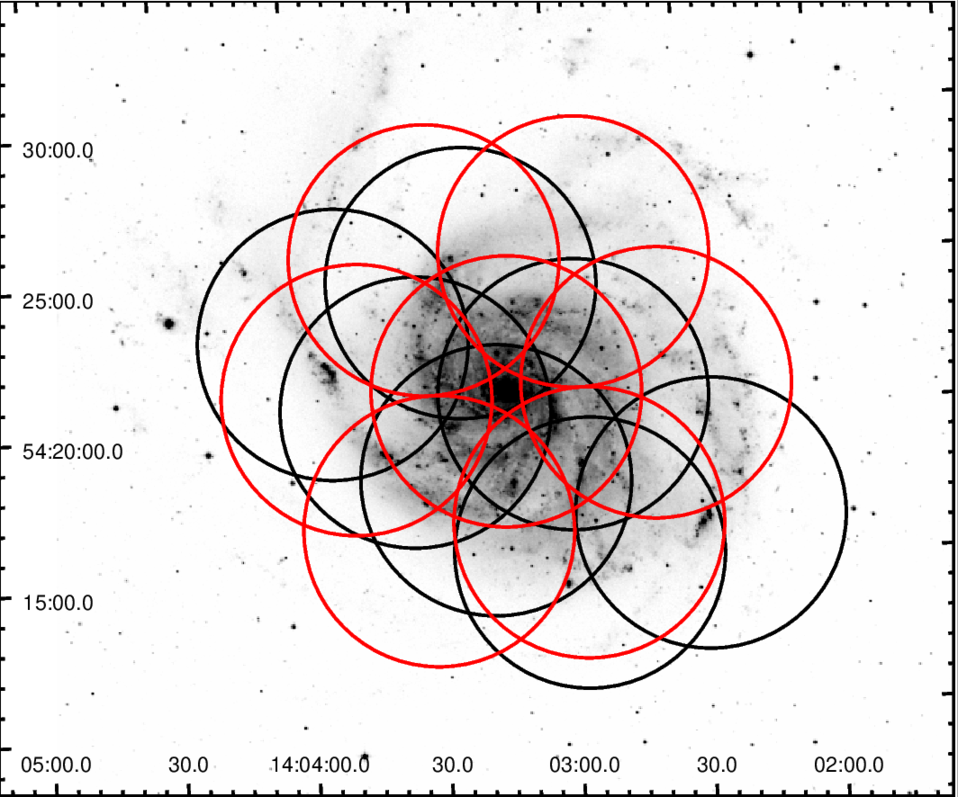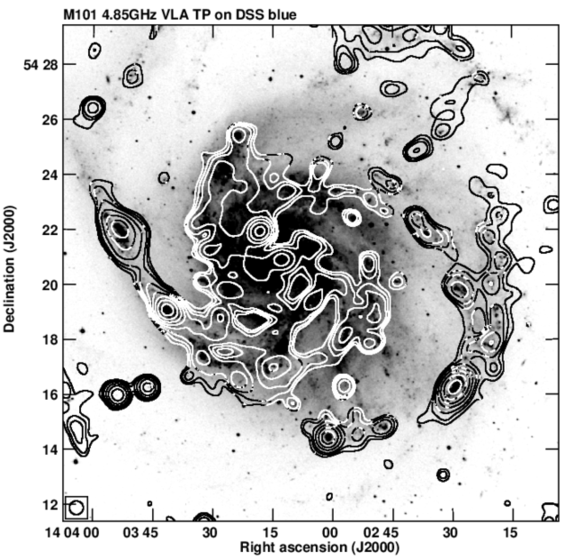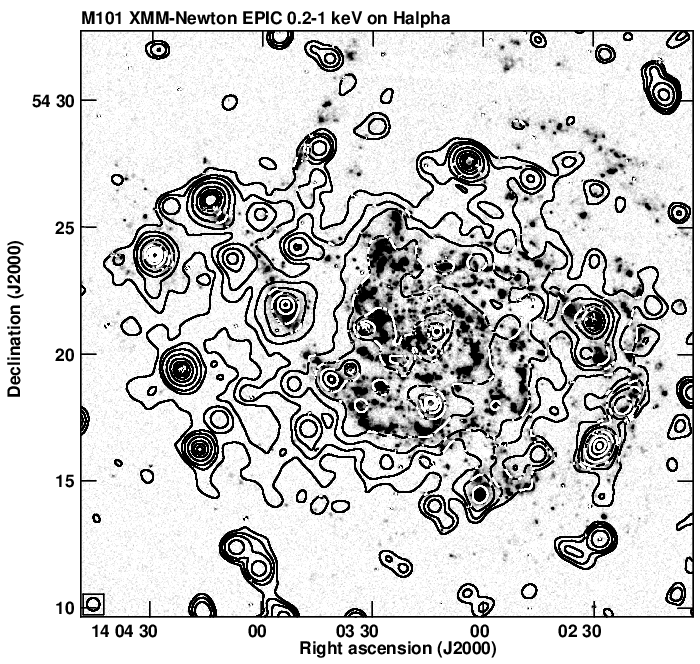Astronomy Object of the Month: 2022, July
< previous Archive next >
M101 – a galaxy too large
M101, also known to many sky enthusiasts as the Pinwheel Galaxy, is big, beautiful and... making troubles. Until recently, there were no radio observations of this galaxy at high
frequencies that could provide a detailed view of its radio structure or give hints about its magnetic fields at smaller scales.
The reason is that this galaxy is so large in the sky that it is difficult to be observed with radio interferometers.

Figure 1: DSS blue image of M101 with all observation pointings marked with circles. See text for details.
<


Figure 2: DSS blue image of M101 with contours of the radio emission: JVLA data (left) or combined JVLA+Effelsberg data (right). The combined data map also shows
the orientation of the magnetic field and the length of the lines is proportional to the polarised radio intensity.
Of course, when this galaxy is observed with a single-dish radio telescope, it is sufficient to just scan the appropriate area of the sky to fully map the galaxy. This was already done by Berkhuijsen et al. (2016, A&A, 588, 114), who presented an extensive analysis of the radio data obtained with the 100-m Effelsberg radio telescope. This study, however, was performed with a relatively low resolution of 2.5 arc minutes at the wavelength of 6 cm. To achieve higher resolutions, interferometric observations, that is, with the use of an array of radio telescopes, are required. All radio telescopes (antennas) within this array observe the same object on the sky and the signal from all of them is correlated and combined. The straightforward advantage of this system is that the size of the array, that is, the longest distance between antennas determines the highest resolution possible.
This is because the measured signal is Fourier-transformed so that the largest scales (distances between antennas) in the array correspond to the smallest scales in the obtained map. At the same time, the smallest scales (distances between antennas) correspond to the largest scales in the map. These largest scales is simply extended (often low surface-brightness) radio emission. Unfortunately, because it is impossible to bring the antennas very close to each other (due to their size or shadowing), we will miss some of these smallest distances (called baselines) and consequently the largest scales in the map. This lack of the shortest baselines is called the missing zero-spacing effect, which results in the largest angular scale (LAS) that can be imaged in the map. For the already mentioned wavelength of 6 cm, the observations performed with the use of the Karl Jansky Very Large Array (JVLA) allow for a detection of emission at scales not larger than around 4 arc minutes, which is not much for typical nearby galaxies, not to mention M101. This obviously causes that a substantial amount of the radio emission is missing in the maps of such objects.
Another property of the interferometric observations that makes the imaging of larger objects difficult is the primary beam – the diffraction limited response of the individual antennas in the array, or, more practically, the field of view. If we want to make the most of our observations, we should focus on the most sensitive central part of this area. As a result, to image an angularly extended object, such as the spiral galaxy M101, many separate observations (so-called pointings) are needed. Figure 1 presents all observations used to produce the radio maps of M101 with archive and more recent dedicated pointings marked with black and red circles, respectively. Despite the complexity of the pointing layout used, the emission lost due to the LAS, mentioned before, cannot be restored that way. The only possibility is to combine these observations with the ones performed with the single-dish radio telescope.
The shortest baselines allowed by the JVLA are 85 metres which perfectly corresponds to the diameter of the Effelsberg radio telescope (100 metres). In other words, we can now use the single-dish data to restore the signal that is not provided by the JVLA for baselines shorter than 85 metres. This makes the combination of these data relatively easy and efficient. The left panel of Figure 2 presents the radio map of M101 at 6 cm as visible by the JVLA only. The strong gradients of the emission visible as dense contours are typical for interferometric observations, in which some of the faint large-scale emission is missing. In the right panel of the same figure the combined JVLA and Effelsberg data are presented and the restored extended radio emission is clearly visible. The flux measurements show that in the left map (i.e. interferometric observations only) as much as 60% of the emission is lost. The right map, in which the entire emission has been restored, allows for precise flux measurements in smaller areas of the galaxy.

Figure 3: Polarised radio intensity map of M101 overlaid on the Hα image. The orientation of the magnetic field is presented with lines, whose length is proportional to the degree of polarisation.
Another interesting area of M101 is found between the central part of the disk and the western spiral arm. Figure 3 shows that this is a relatively 'empty' area, where neither Hα nor polarised radio emission is present. The total radio emission (right panel of Figure 2) is also weak in this position and the study of the emission from the neutral hydrogen performed by Braun (1995, A&AS, 114,409) reported a significant depression in this area. Nevertheless, the soft X-ray map that presents the emission from the diffuse hot gas does show notable extension there (Figure 4). The analysis of the associated hot gas suggests that it is slightly hotter than the surrounding medium. If this was confirmed by more sensitive observations, that would mean that also in this area the gas heating by the magnetic reconnection is possible. Although, as mentioned before, no polarised radio emission is present there, the two frequency radio study performed by Berkhuijsen et al. (2016, A&A, 588, 114) suggest the existence of the vertical magnetic field in this part of the galaxy. This in turn would mean, that the magnetic reconnection might occur in the halo of M101.

Figure 4: Contours of the soft X-ray emission from M101 overlaid on the Hα map.
Original publication: Marek Weżgowiec, Rainer Beck, Michał Hanasz, Marian Soida, Matthias Ehle, Ralf-Jürgen Dettmar, Marek Urbanik, Magnetic fields and hot gas in M101, accepted for publication in A&A.
The research was conducted at the Department of Radioastronomy and Space Physics of the Jagiellonian University’s Astronomical Observatory (OA UJ). The work was supported by the Polish National Science Centre through the grant 2017/27/B/ST9/01050.
|
Marek Weżgowiec Astronomical Observatory Jagiellonian University M.Wezgowiec [at] oa.uj.edu.pl |


